Veterinary Advice Online - Sexing Parakeets (Budgerigar or Budgie Sexing).
Veterinary Advice Online - Sexing Parakeets (Budgerigar or Budgie Sexing).
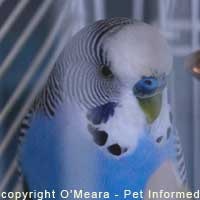 Many owners of parakeets (also called budgerigars or "budgies") find it very difficult to determine the gender or sex of their avian pets and often need their veterinarian or their local bird-breeder
to sex their parakeets for them.
Many owners of parakeets (also called budgerigars or "budgies") find it very difficult to determine the gender or sex of their avian pets and often need their veterinarian or their local bird-breeder
to sex their parakeets for them.
But sexing parakeets is actually very easy when you know how.
This page contains everything you, the pet owner, need to know about parakeet sexing (budgerigar gender determination). The "how to sex parakeets" information provided on this page is supported by a number of helpful male and female budgerigar pictures and links to useful budgie sexing sites that clearly illustrate how to distinguish the boys from the girls. Parakeet sexing topics are covered in the following order:
1. Some basic dos and do nots when handling and sexing parakeets for the first time.
2. A pictorial guide to how to sex parakeets - is your budgie a male or a female?
2a) Examining the colour of the parakeet's cere.
2b) Examining the colour of the parakeet's feet and legs.
2c) Only female birds lay eggs.
2d) Male parakeets have larger heads and bodies than the female parakeets do.
2e) DNA bird sexing (avian DNA sexing): bird DNA feather sexing, blood DNA sexing and eggshell DNA sexing.
2f) Endoscopic bird sexing - what it is and the advantages and disadvantages.
3. Good budgie sexing links (includes links to genetics company sites who provide DNA bird sexing).

1. Some basic dos and do nots when handling and sexing parakeets for the first time.
There is not too much that can go wrong when attempting to determine the sex or gender of a budgerigar,
so long as you are gentle, however, I will draw your attention to a couple of important budgie handling points, which should be taken into consideration.
Some parakeet sexing and handling pointers:
- Handle pet birds very gently and quietly, for as short a period of time as possible. Birds are easily stressed and can die from fear and heat exhaustion if handled excessively or roughly.
- If attempting to sex parakeets by their cere colour (the colour of the nostril band at the top of the beak), wait until they are mature (over 12 months old). The cere colour is not helpful for determining parakeet gender in juvenile birds.
- If attempting to sex budgies by their cere color, the budgies can usually be examined easily enough whilst still in their cages. You shouldn't need to handle parakeets and stress them out
if you are just examining the cere - it is very visible and obvious.
- Alternatively, if attempting to sex tame budgerigars (parakeets) by their cere color, the budgies can be examined while perched upon your hand. Parakeets do not need to be grabbed and man-handled just to check their ceres.
- If firmer handling is needed (e.g. to pluck feathers from the bird for DNA bird sexing, also known as DNA feather sexing), you should grasp your parakeets gently, but firmly around the body (wings included). Do not squeeze the birds too hard when sexing parakeets because this can suffocate them (all birds need to lift their sternums outwards to breathe). If possible, hold your birds in an upright position (in their normal perching position) because birds may find it hard to breath if held upside down or on their backs.
- Be careful when sexing parakeets. Nervous parakeets do bite hard!
- Feather plucking (when DNA sexing parakeets) can be painful and stressful for birds, particularly if
many large feathers are required. This stress and pain can be reduced by performing the plucking procedure
under a very quick, relatively-safe, gaseous anaesthetic. Your vet can provide this service for you.
- Although this might seem a tad obvious, always perform parakeet sexing or any other parakeet examination indoors. This way, the bird will not be able to escape into the dangerous outdoors environment if it should manage to wriggle out of your hands. Be sure to choose an indoors environment that is also safe
for the bird, should it escape you. I have seen many horribly burnt feet that were the result of parakeets and cockatiels fluttering down onto oven hotplates!
- Although this might also seem a tad obvious, if the budgie has had its wings clipped you should
perform the parakeet sexing procedure (or any other parakeet examination) on the floor or on a low table
(e.g. a short coffee table). This way, if the bird gets away, no injury will occur from the animal falling from a great height.
- When sexing parakeets, try not to handle extremely newborn parakeets if you can avoid it. Mother budgerigars (especially new mothers) can become uncertain of their newborn chicks if you handle them too much and get your human smell all over them. This can potentially lead to the mother bird rejecting her budgerigar babies.
- If you have to handle and sex newborn or unfledged budgerigars, wear disposable gloves (so you don't pass on any diseases to them) and do so in a warm area and for no more than 5 minutes at a time so that they do not get cold and distressed. Consider DNA sexing (using the discarded egg shells) of very newborn budgerigars.
- Wear disposable gloves and mask if handling newly-acquired birds whose background (history, breeding, where they came from and so on) is unknown (this includes pet shop and aviary-born birds).
This is particularly important if the bird shows any signs of respiratory illness, sneezing,
nasal discharges, skin sores, feather loss (bald spots), scaly skin or diarrhea or if you already have healthy pet birds back at home. Budgerigars can carry a range of diseases that are contagious to humans and other birds, especially Psittacine species (e.g. mites, coccidia, Psittacosis, BFDV - avian beak and feather disease virus
and so on), and wearing gloves and a surgical mask when handling will help to reduce disease transmission.

2. How to sex parakeets - is your budgerigar (budgie) male or female?
The simplest and most non-invasive way of determining the sex of a parakeet is to wait until the bird reaches maturity
(reaches adulthood - more than 12 months old) and develops its mature-age
cere colouring. The color of the cere differs between male and female budgie genders and is quite distinctive. If parakeet sexing needs to be
performed on juvenile birds (prior to attaining their obvious adult cere pigmentation)
or on non-pigmented or ambiguously-pigmented adult birds (e.g. albinos, lutinos, recessive-pied variants or dilution-color parakeets), then more complicated, invasive methods of sexing parakeets may be required, including DNA bird sexing (DNA feather sexing or avian DNA sexing) or endoscopic surgical sexing.
1. Examining the colour of the mature parakeet's cere.
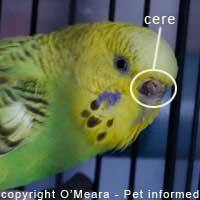
The cere is the band of raised skin across the top of the bird's beak, which encompasses the
parakeet's nostrils. Male and female
juvenile birds (under 12 months of age) generally have a pale blue, pink or violet cere, which is not sex dimorphic. When parakeets mature (reach 8-12 months of age and above), their cere colour changes depending upon
whether the bird is a male or a female. In mature male budgies, the cere is a bright blue or rich violet colour. In mature female budgies, the cere can be a rich brown colour (like oiled leather), a lighter tan colour or, occasionally, a very pale, whitish-blue colour.
Author's note: The cere colour in the mature
male parakeet is sometimes dependent upon
the bird's overall body colour. Male parakeets with normal feather coloration have a blue or violet cere
(as described above). Male birds with dilution-type colors (e.g. albinos, lutinos and certain recessive-pied, clear and mottled-variety parakeets) may not change their cere colour all that
much upon reaching maturity and retain their juvenile pink or violet cere colors.
Author's note: The brown colour seen in the cere of female parakeets comes as a result of the effect of rising estrogen levels on the bird's skin. When oestrogen levels rise in the mature female budgie, the cere changes colour
to brown or tan. Oestrogen is the "female hormone" made when the ovary (the female reproductive organ) starts to cycle in the mature animal. Older
male budgies that develop oestrogen-secreting testicular tumors can sometimes develop a brown cere as a result of the estrogen's effect on the cere.
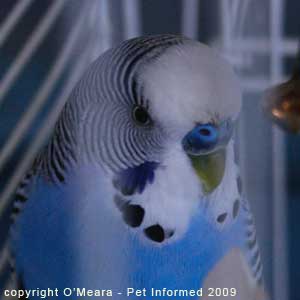
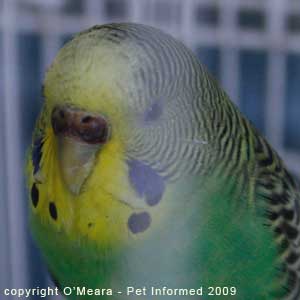 Sexing parakeets picture 1:
Sexing parakeets picture 1: This is an image of the head of a healthy boy budgie. The bird's cere
is bright blue.
Sexing parakeets photo 2: This is an image of the head of a healthy girl budgie. The bird's cere
is a rich brown colour.
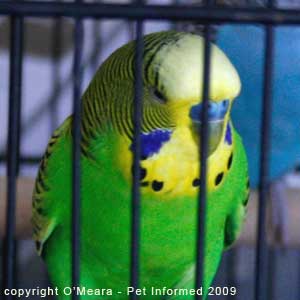
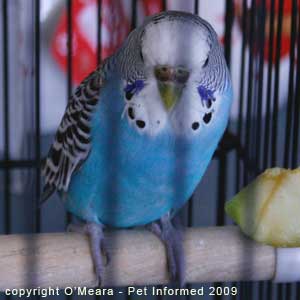 Sexing parakeets picture 3:
Sexing parakeets picture 3: To prove that the blue cere shown in image 1 (first "sexing parakeets" image)
was not just the result of the bird's overall blue feather coloration, here is another image of
a male parakeet. The feathers of this bird are green and yellow, but the cere is still bright
blue, in keeping with the sex of the male parakeet.
Sexing parakeets picture 4: To prove that the brown cere shown in image 2 (second "sexing parakeets" image)
was not just the result of the bird's overall green and yellow feather coloration, here is another image of
a female parakeet. The feathers of this bird are blue and white, but the cere is still a rich
brown, in keeping with the sex of the female parakeet.
 2. Examining the colour of the parakeet's feet and legs.
2. Examining the colour of the parakeet's feet and legs.
The sex hormone effects responsible for making the male parakeet's cere blue and
the female budgerigar's cere brown, also act on the skin of the birds' legs and feet, turning them
a similar colour to the sex-respective cere skin. When parakeets mature (over 12 months of age), their legs and feet
change colour depending upon whether the bird is a male or a female. In mature male budgerigars, the feet
and legs are bright blue. In mature female budgerigars, the feet and legs are a pink or brown colour.
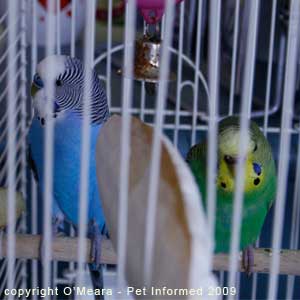
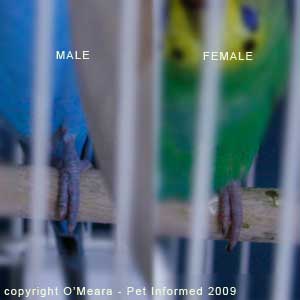
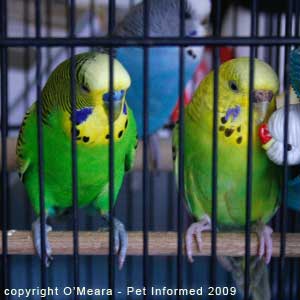 Sexing parakeets picture 5:
Sexing parakeets picture 5: This picture contains a male (blue feathers) and
a female (green and yellow feathers) parakeet perching side-by-side in a cage. The male bird's feet
are blue and the female bird's feet are browny pink.
Sexing parakeets picture 6: This is a close-up image of the feet of the budgies shown in "sexing parakeets" image 5. The male bird's feet are on the left and the female bird's feet are on the
right of the image. The male bird's feet
are blue and the female bird's feet are browny pink.
Sexing parakeets photo 7: This sexing parakeets picture contains a male (left) and
a female (right) parakeet perching side-by-side in a cage. The male bird's feet
are blue and the female bird's feet are browny pink.
 3. Only female birds lay eggs.
3. Only female birds lay eggs.
If one of your parakeets lays an egg, then it is a female. Only female birds
lay eggs. Please note, however, that the absence of egg-laying in a bird does not,
by-default, make it a male. Female budgerigars fail to produce eggs for a variety of reasons, including:
age (too young or too old), malnutrition, egg-binding, uterine disorders, ovarian
disease, reproductive tract infections and various stressors.
 4. Healthy male budgerigars have a larger body and head than healthy females.
4. Healthy male budgerigars have a larger body and head than healthy females.
Mature male parakeets tend to be larger in size and weight than mature female parakeets. Males are stronger and have a bigger-build than the females. Males also tend to have a much larger head than the females do, when compared to their respective body sizes.
Their body feather colors are often much more vibrant than those of female birds as well.
Author's note: Feather colours may be naturally muted (non-vibrant) in male and female birds who are
inbred or of "fancy" non-wild-type colouring (e.g. albino, lutino, dilution-colours, cinnamon-colours, sky blue, pale yellow, light green, various mottled or pied colours). Male body size may be artificially reduced in birds who are malnourished, stunted, in-bred, unwell
or otherwise poorly-grown.
 Sexing parakeets picture 8:
Sexing parakeets picture 8: The male parakeet (left) is larger in size, with a bigger head, than the
female perched next to him (right). His feather colours are also much more vibrant than hers.
 5. DNA bird sexing (avian DNA sexing) - bird feather sexing, blood sexing and eggshell sexing.
5. DNA bird sexing (avian DNA sexing) - bird feather sexing, blood sexing and eggshell sexing.
The body features mentioned so far (subsections 1-4, above), which can be used to determine the sex of parakeets,
are not all that useful in determining the sexes of budgies under the age of 12 months. If parakeet sexing needs to be
performed on juvenile birds (less than 12 months of age - prior to attaining their obvious adult cere pigmentation)
or on non-pigmented or ambiguously-pigmented adult birds (e.g. albinos, lutinos, recessive-pied variants or various
dilution-color parakeets), then more complicated, invasive methods of sexing parakeets may be required. One of these
is
DNA bird sexing (avian DNA sexing).
In DNA sexing, a fresh sample of the bird's blood or another body tissue (e.g. feathers or eggshells), which contains the nucleated cells of the bird and, therefore, by default, the entire blueprint of the bird's genetic DNA make-up, is sent to a genetics laboratory for sex determination. At the laboratory,
the DNA from the bird cells is extracted and amplified (i.e. multiplied using a special technique
called PCR) and combined with special, breed-specific, sex-specific DNA markers that are designed to detect whether the bird DNA in the sample contains ZZ sex chromosomes
(i.e. the DNA is male) or ZW sex chromosomes (i.e. the DNA is female). The DNA sexing
result is then sent back to the bird's vet or directly to the bird's owner.
Most genetics labs these days have the capacity to determine the sex of a broad range of avian species and types. Being such a common pet, budgerigars are most certainly included
upon that list of testable bird breeds. The link below shows the list of bird species that are able to be sex-tested by one of the companies providing this DNA sexing service. This list of testable breeds is by no means exhaustive and is probably increasing by the day.
http://www.avianbiotech.com/SpeciesList.asp
Any body tissue that contains DNA can be used to sex parakeets, however, in order to make
the sexing process as minimally invasive and low-stress for the bird as possible
and as simple-to-perform as possible for the vet or bird owner, most labs can now perform
the DNA sexing procedure on samples of feathers, blood and eggshells (the shells
discarded by day-old-chicks during the hatching process), which are easily obtained. Most labs will even send special sample collection kits out directly to bird owners, so that they can collect the DNA-containing samples themselves at home. At the end of this page, I have included some links to genetics companies who provide this do-it-yourself mail service.
Some points about DNA feather sexing:
- The DNA testing is performed on feathers plucked freshly from the bird.
- The DNA to be tested comes from the region of the feather shaft located underneath the bird's skin.
- Fallen or molted feathers are not to be used. They must be freshly plucked.
- Blood feathers will work okay, but are not necessary. Mature feathers will work just as well.
- If used, blood feathers should be allowed to dry before being placed into the lab sample bag.
- Feather sexing is safer and less-stressful to perform than blood-sample DNA sexing.
- Different genetics labs have different feather submission rules (e.g. length of feathers needed, number of feathers needed, place on the body where the feathers must be plucked from and so on) so you need to read the instructions carefully before pulling any feathers out and submitting them.
- Feather sexing is thought to be as accurate as blood DNA sexing.
Some points about DNA blood sexing:
- Blood sexing is less safe and more stressful to perform than DNA feather sexing.
- Blood sexing is thought to be no more accurate than DNA feather sexing.
- Only 1-2 drops of blood are needed in order to perform DNA blood sexing.
- Blood can be obtained from veins in the neck, wings and legs of the bird, but such venepuncture is stressful and tricky to perform on the healthy, struggling bird and can result in excessive blood loss (dangerous in small birds).
- Clipping the end of a toenail slightly short such that 1-2 drops of blood
are obtained usually works fine and is the safest bleeding method for the bird. After collecting
the sample, make sure to blot the bleeding nail with a tissue or soap-bar and ensure that the bleeding has stopped before releasing the bird.
- Most labs provide a do-it-yourself blood sample paper (blood card) for collecting the blood
sample. The bird's blood is blotted onto the appropriate section of the card, air-dried and then packed into the sample kit for sending back to the lab.
- If using nail clippers to clip the bird's claws and collect the blood, ensure
that the nail clippers used are washed thoroughly (very hot water) between birds, if more than one bird
is being sampled. This will prevent the transmission of blood-borne diseases from bird to bird
and it will also prevent contamination of the samples with the blood from other birds (which could lead to an
erroneous lab result).
Some points about DNA egg-shell sexing:
- Freshly-cracked eggshells contain cells and DNA from the newly-hatched chick. These
cells can be used to determine the sex of the parakeet chick that emerged from the shell in
question.
- The eggshells need to be fresh.
- The eggshells to be tested should not have been contaminated by other hatching chicks and eggshells.
It is no good if blood-or-membrane-covered shells have become all mixed together (contaminating one another with DNA)
or if they have had a number of slimy, DNA-covered chicks crawling all over them.
- Eggshell sex determination is particularly useful in parakeet breeding colonies.
- Eggshell sex determination is much less stressful than blood or feather sexing.
- Eggshell sex determination can be used to determine the sex of parakeet chicks from only a few hours old.
- Eggshell sex determination of chicks does not run as much risk of disturbing the mother bird.
- Most labs provide a do-it-yourself sample kit for collecting the egg shell samples. The shells are collected, labeled, air-dried and then packed into the sample kit for sending back to the lab.
IMPORTANT: Sending feather, blood and/or egg-shell samples or any
other avian biological samples overseas or inter-state by post (even if in a suitable sample
collection package) may be illegal. Many states and countries forbid the sending of biological materials by post
because of the risk of exotic disease transmission (e.g. avian flu) to postal workers
and other avian species. Where possible, you should elect to use the services of a
bird-sexing genetics company in your own country and/or state and, even then, you should contact the gene company and your local postal service to be sure that it is legal for you
to send such samples through the mail.

6. Sexing Parakeets - Endoscopic Bird Sexing.
Before the advent of DNA sexing, many species of birds (particularly juvenile birds and birds without obvious physical male-versus-female differences) could only be reliably
sexed using endoscopy. Known as surgical sexing, endoscopic bird sexing required the bird to be placed under
an anaesthetic so that an endoscope (basically, a long, thin rod with fibre-optic imaging
equipment set into the shaft to allow visualisation of the bird's internal organ structures)
could be inserted through the skin and into the abdominal airsacs of the bird. Part of the bird's unique respiratory
system, the airsacs of a bird are basically large chambers of air with see-through, ultra-thin,
membranous walls. When the endoscope is inserted into the abdominal airsacs of the bird, the entire organ
system of the bird's abdominal cavity, including the bird's reproductive organs, is visible through the airsac's membranous wall. The vet performing the endoscopic sexing can determine
whether the bird is male or female based upon the appearance and number of the reproductive organs.
Males have two internal testicles and females have only a single internal ovary.
Because it is much more invasive and risky than DNA feather sexing and other forms of DNA bird sexing,
endoscopic sexing is likely to become much less common for purposes of gender determination
than it has been. This trend away from invasive endoscopy will only continue as the DNA sexing tests become more and more
readily available and cost-effective and cover more and more species of birds. Because parakeets (budgerigars) already
have a readily-available DNA sexing test designed to meet their
needs, it is most unlikely that endoscopy will ever really be needed to sex this species. Endoscopic bird sexing
is most likely to be used in situations where DNA testing is unavailable; in species that have no DNA sexing test available to them and in multiple-bird, constricted-finance situations (e.g. wildlife groups, high-output budgie breeding facilities and zoos) where the cost of mass DNA testing might actually end up more expensive than having an endoscope on-site.
Pros (advantages) of endoscopic bird sexing, including sexing parakeets:
- In the hands of a skilled operator, surgical sexing is quick to perform.
- The endoscope procedure allows other internal organs to be viewed and examined.
- With experience, surgical sexing is quite accurate to perform.
- The examination is not dependant upon the bird being sexually mature.
- It allows bird species with no DNA sexing test available, to be sexed.
- In experienced hands, the vet can also get some idea of what stage the female bird is at with regard to her sexual maturity and her stage of the breeding cycle.
Cons (disadvantages) of endoscopic bird sexing, including sexing parakeets:
- An anaesthetic is needed, which might be of risk to the bird.
- There is some risk of peritonitis (infection of the internal abdominal cavity) and airsacculitis (infection of the air sacs) with this procedure if aseptic procedure is not followed.
- A fair bit of relatively costly equipment is needed.
- The procedure is more stressful and invasive than DNA sexing.
- There is a greater chance of hemorrhage, which can be risky in small birds.
- There is a greater risk of trauma to the internal organs, which can be risky.
- There is a greater risk of rib fractures.
- It can be difficult to visualize the gonads (and therefore the sex) of fat birds.
- Endoscopic sexing needs an experienced operator to get the best result.
- It can only be done by a vet or other person licensed to anesthetize and perform surgery on birds.
- For operators, there is the risk of infectious disease organisms (e.g. Chlamydia) infecting the operator.
- On an individual basis, endoscopy is potentially more costly to owners than DNA sexing.

Your Sexing Parakeets Links.
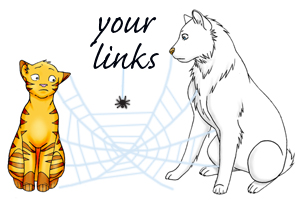 To go from this sexing parakeets page to our great homepage, click here.
To go from this sexing parakeets page to our great homepage, click here.
To go from this parakeet sexing page to our sexing animals page, click here.
http://www.budgies.org/info/faq.html
A nice general FAQ sheet on budgies. Includes info on sexing parakeets.
http://www.budgieplace.com/index.html
An awesome budgie and parakeet site. Has good parakeet sexing and feather-colour sections and lots of pictures.
Some companies that provide DNA bird sexing services (not exhaustive - there are many others):
http://www.dnasolutions.com.au/dna-sexing.htm
http://www.saturnbiotech.com.au/serv-birdsex.html
http://www.dnanow.com/dna-bird-tests.htm - US company.
http://www.healthgene.com/avian/dna_sexing.asp
http://www.avianbiotech.com/SexingCenter.htm
http://www.avianbiotech.com/questionsaboutfeathersexing.htm
http://www.avianbiotech.com/SpeciesList.asp

"Sexing Parakeets" Copyright August 15, 2009, Dr. O'Meara BVSc (Hon), www.pet-informed-veterinary-advice-online.com.
All rights reserved, protected under Australian copyright. No images or graphics on this Pet Informed "Sexing Parakeets" page may be used without written permission of their owner, Dr. O'Meara.
Please do not steal our "Sexing Parakeets" images: a lot of time and effort goes into getting these pictures
so that people can view them on our site.
Important disclaimer: Please note that this author and website is in no way affiliated with any of the genetics companies or budgie information websites that were listed or linked-to on this sexing parakeets page. Pet Informed's reasons for mentioning these companies and websites
is so that readers interested in reading more about parakeet sexing or obtaining avian sexing DNA services
will know where else to turn. Pet Informed receives no commercial or reputational benefit from any of these companies or websites for mentioning them and can not make any guarantees or claims, either positive or negative, about these websites' information accuracy, products, customer service practices or business practices.
Choosing to access DNA bird sexing services from any company on the web is your decision alone and Pet Informed can not and will not take any responsibility for any death, damage, injury or loss of reputation and business
that occurs should you choose to take this sex-determination path with your bird. Do your homework and research all such parakeet sexing products carefully before spending your money and risking your pet's health on any such products.
 The cere is the band of raised skin across the top of the bird's beak, which encompasses the
parakeet's nostrils. Male and female juvenile birds (under 12 months of age) generally have a pale blue, pink or violet cere, which is not sex dimorphic. When parakeets mature (reach 8-12 months of age and above), their cere colour changes depending upon
whether the bird is a male or a female. In mature male budgies, the cere is a bright blue or rich violet colour. In mature female budgies, the cere can be a rich brown colour (like oiled leather), a lighter tan colour or, occasionally, a very pale, whitish-blue colour.
The cere is the band of raised skin across the top of the bird's beak, which encompasses the
parakeet's nostrils. Male and female juvenile birds (under 12 months of age) generally have a pale blue, pink or violet cere, which is not sex dimorphic. When parakeets mature (reach 8-12 months of age and above), their cere colour changes depending upon
whether the bird is a male or a female. In mature male budgies, the cere is a bright blue or rich violet colour. In mature female budgies, the cere can be a rich brown colour (like oiled leather), a lighter tan colour or, occasionally, a very pale, whitish-blue colour. 







 Many owners of parakeets (also called budgerigars or "budgies") find it very difficult to determine the gender or sex of their avian pets and often need their veterinarian or their local bird-breeder
to sex their parakeets for them.
Many owners of parakeets (also called budgerigars or "budgies") find it very difficult to determine the gender or sex of their avian pets and often need their veterinarian or their local bird-breeder
to sex their parakeets for them. 